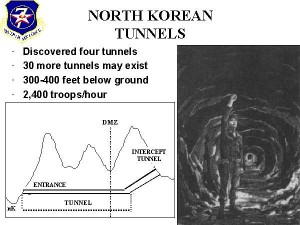by Jack  I happened to tune to the Discovery Channel today and there was a program about the DMZ or demilitarized zone that separates North Korean from South Korea. It was a fascinating story. I was reminded of my friend, you know him as Soaps. He served there for about a year in a special military unit.
I happened to tune to the Discovery Channel today and there was a program about the DMZ or demilitarized zone that separates North Korean from South Korea. It was a fascinating story. I was reminded of my friend, you know him as Soaps. He served there for about a year in a special military unit.
No doubt he had an interesting time, because while he was there this was the scene of many NK incursions and provocations, some leading to US casualties. The DMZ is comprised of a strip of land 1.2 miles wide and 150 miles across. In the middle is the small village of P’anmunjom, where the cease fire agreement was negotiated and finally signed into agreement in 1953.
This (DMZ) land remains basically untouched by man since 53’ and it divides two million combat ready soldiers. Ironically, it has become home to a number of endangered species that thrive in this new wilderness.
Since the truce was signed the North Koreans have made it a regular practice to sneak across this border to commit acts of sabotage or to kill NATO border guards. This has caused a number of incidents that almost resulted in a restart of the Korea war.
The US military supplies most of NATO troops assigned to border protection, which means they would be the first to confront the North Koreans should they invade. In the early 1970’s the South Koreans discovered three large invasion tunnels dug by the North Koreans presumably to sneak under the fortifications and the mine field. The tunnels could handle up to 30,000 soldiers passing through them per hour! I know the picture says less, but that was before the largest tunnel was discovered. As the NK soldiers exited they would be just 27 miles from Seoul, the capital.
A 4th tunnel was found in 1990, but its believed that up to 20 more tunnels still exist hidden hundreds of feet underground. North Korea denied any hostile intent and claimed these were mere peaceful coal mines and to prove it, they had spray painted the words, “coal mine” on the granite rock which contains no coal. See, it must be a coal mine, the graffiti says so.
Global Security writes, “On March 3, 1990, the ROK and U.S. combined forces found the north Korean’s fourth invasion tunnel about 261km northeast of Yanggu in Kangwon-do Province. The location of this tunnel, the first to be found in the Eastern Sector of the Demilitarized Zone, clearly indicates that north Korea has dug invasion tunnels (estimated total well over 20) along the entire stretch of the front line.
This tunnel was buried 145 meters below ground and measured 2 meters high and 2 meters wide, large enough for three armed soldiers to run through side-by- side. On March 9, 1990, north Korea, for the first time, admitted in a propaganda broadcast in the DMZ that they dug the fourth tunnel. They claimed that the purpose of this tunnel was to “facilitate peaceful reunification” by “replacing the concrete wall” that the north falsely alleges the South built.
The UNC protested this act of provocation and blatant violation of the Armistice Agreement at the 455th MAC meeting held March 14, 1990.” Numerous provocations have occurred since the truce in 1953, but most of the US casualties occurred during the 1960’s, a time of particular unrest in the DMZ.
The last US death occurred in 1973 while US and ROK soldiers were inspecting one of the North Korean invasion tunnels when a powerful hidden bomb went off. The North had been invited to join this inspection team, but for some reason they declined, now we know why.
Tourists from the South are allowed to see one of the larger invasion tunnels that looks like you could drive a tank through it, but only for a short distance. South Koreans concreted it near the middle to prevent reopening by the North. Tourists can also view the North Korean guards through telescopes. No tourists are ever seen on the North’s side. A complete village was created on the PRNK’s side, but it appears all for show. Nobody actually lives there, but someone flips the lights on and off at night…weird.
